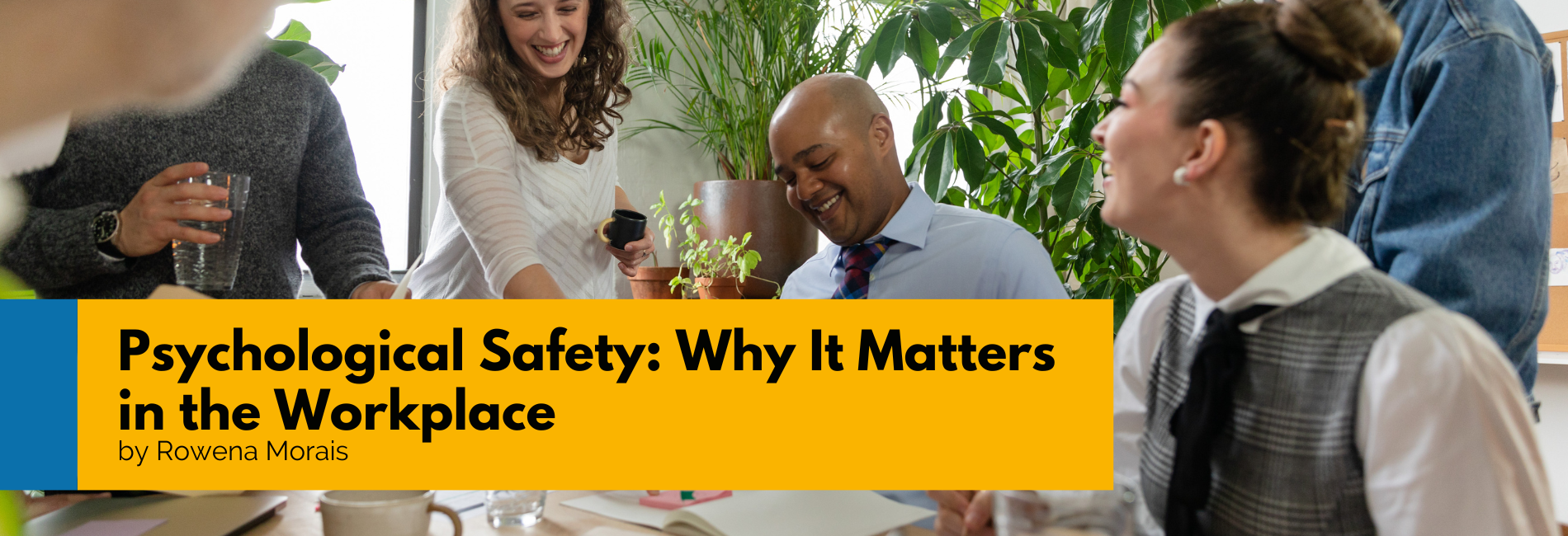
Feeling Safe and Empowered
Written by Rowena Morais
What is psychological safety?
‘Psychological safety’ was first coined by Amy Edmondson, the Harvard Business School professor and author of The Fearless Organization. Amy defines psychological safety as a shared belief held by members of a team that it is ok for anyone to take risks, express their ideas, raise concerns, ask questions, and admit mistakes – without fear of negative consequences.
Why do we, as organisations, want safe conversations?
We want individuals and groups who are free to speak up and raise concerns when everyone else is silent. It prevents groupthink and ‘yes’ people who go along with the loud majority.
To support an environment where we’re leading and driving innovation, we must look out for each other within our teams and communicate with care. While failures can be upsetting, they are also opportunities to learn, and not just disasters to be chastised for. If we are one-dimensional in addressing failure, it can lead to erasure of curiosity.
Safe Work Australia published new information in February 2024 identifying trends in psychological safety in workplaces. The Psychological health and safety in the workplace report highlights the changing impact of work-related psychological injuries in Australia.
The report shared that during 2021-22, mental health conditions accounted for 9% of all serious workers’ compensation claims, a 36.9% increase since 2017-18. It was also reported that workers with claims for mental health conditions experienced poorer return-to-work outcomes and were more likely to experience stigma from colleagues and their employers.
What does the lack of psychological safety create?
Scenario 1: Jane feels physically ill at the thought of reporting back to her manager, Michael, on a botched project they both have been working on over the last 18 months.
Scenario 2: Mei Lee, who is in a massive business transformation project at a large local telco gets regularly taunted for being a “goody two-shoes”. She notices something amiss in one of the company’s products due to a few skipped processes, one of which is a regulatory requirement. Most have noticed it but let it pass. Anxious, Mei Lee is unclear how to move ahead. Should she say anything?
“It’s the way it has always been done. What do you know anyway?”
“This is how we do things here, and that’s that.”
“Leave it well alone.”
How do we ensure that everyone feels safe, welcomed, and included? Will everyone’s voice be heard? This is not just about progress and innovation.
In certain situations, how do we avoid catastrophic disasters and grave harm to individuals or communities? Take the Titan submersible disaster, as an example, where two former OceanGate employees separately voiced safety concerns but found their voices dismissed.
How do you know if psychological safety exists in your team and organisation?
Workplaces must be psychologically safe for all and it’s fairly easy to identify a safe, supported environment.
If you make a mistake, it’s not held against you. You feel free to raise concerns and ask questions. You hear different opinions and voices within teams.
You’re told that it’s safe to take a risk – and that’s also your experience. Your skills, experience and insights are valued and utilised. The collaboration and debates can be wide-ranging but it’s healthy and forward-oriented.
Play the long-game
Safe conversations, and safe workplaces, are key to organisational success. As managers and leaders, we want to mobilise employees towards unified goals and outcomes. However, are these goals and outcomes always clear, understood, and accepted?
When individuals know that they can have open conversations with colleagues, team leaders and managers, then they can speak freely, take risks, explore ideas, and even raise questions or concerns.
Yet, as managers, we cannot expect that everyone is already free to do that. We must continually examine our systems, processes, structures and relationships not simply to confirm our biases and beliefs but to question whether systems and processes in place are working to support everyone. We have to communicate with care.
Additionally, leaders must also model the behaviours they seek to promote in others.
Pause and listen
Is it difficult to promote psychological safety?
Yes, it may be difficult to do so if you view everything only through your own rose-coloured lens and believe that your view is the right one.
Everyone has a voice and an approach.
People have ideas bubbling over and can contribute to the collective good but appropriate structures and systems need to be in place so everyone has the opportunity and is supported in being heard.
This calls for a pause long enough to care, listen and consider that there are more ways than one to resolve any issue. It may seem complex and difficult at times, but if there’s a will, there are resources, and support structures in place so organisations and their leaders can make psychological safety a reality for all.
#PsychologicalSafety #SafeWorkplace
